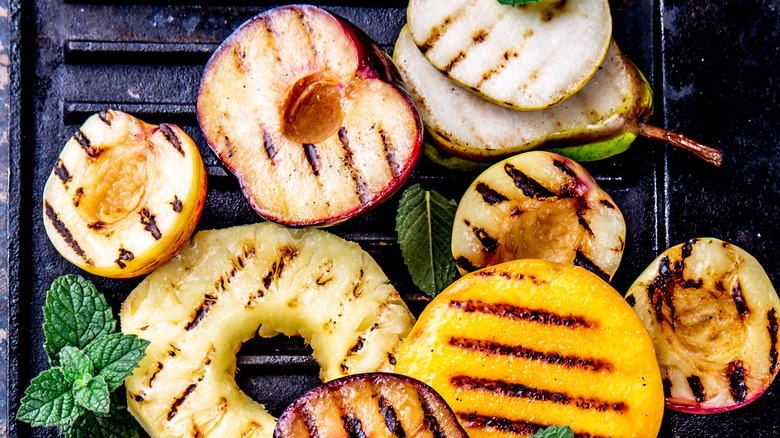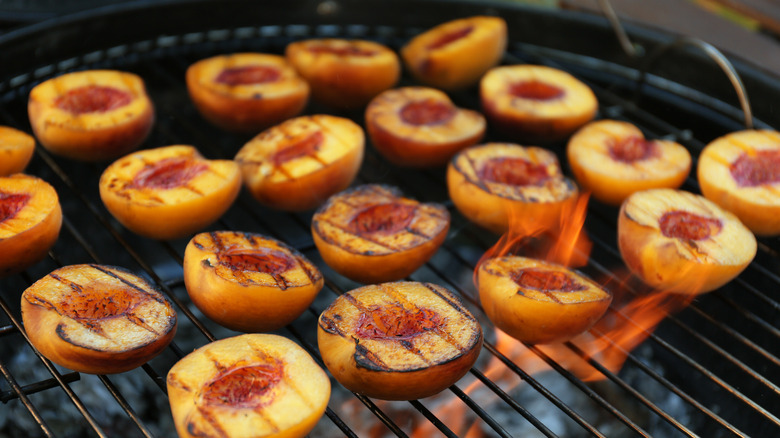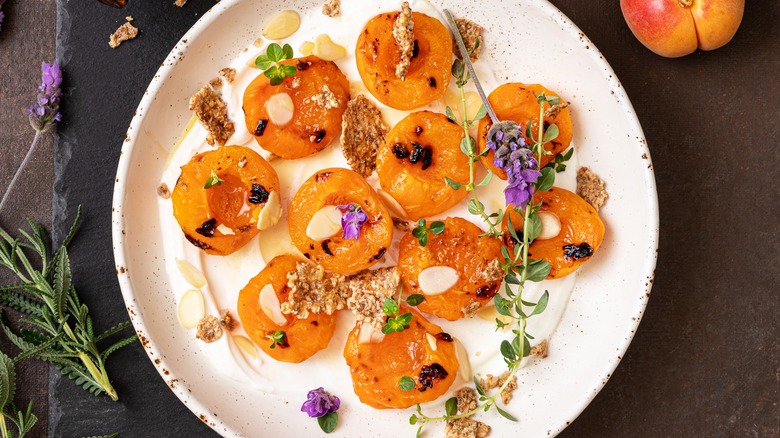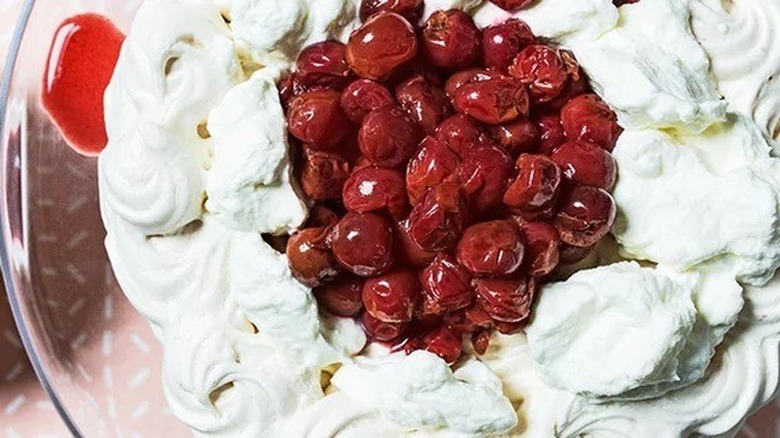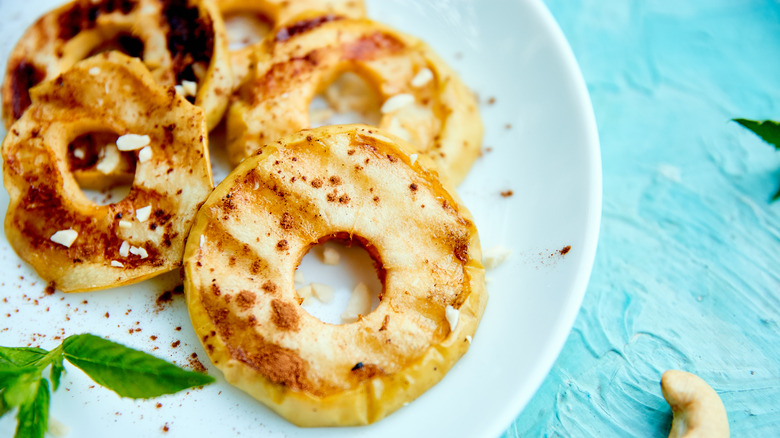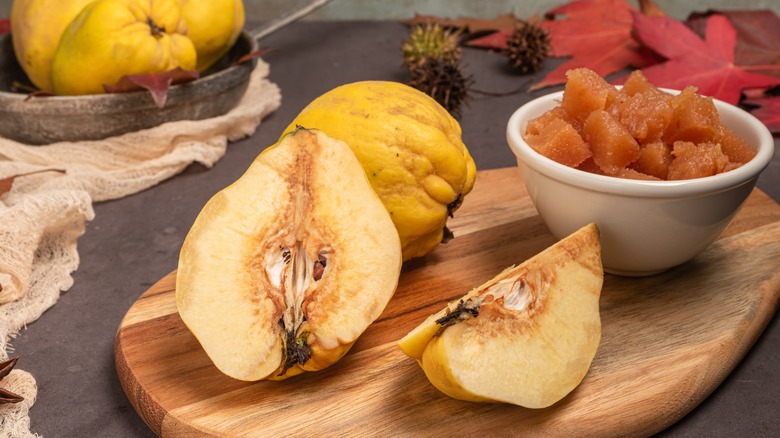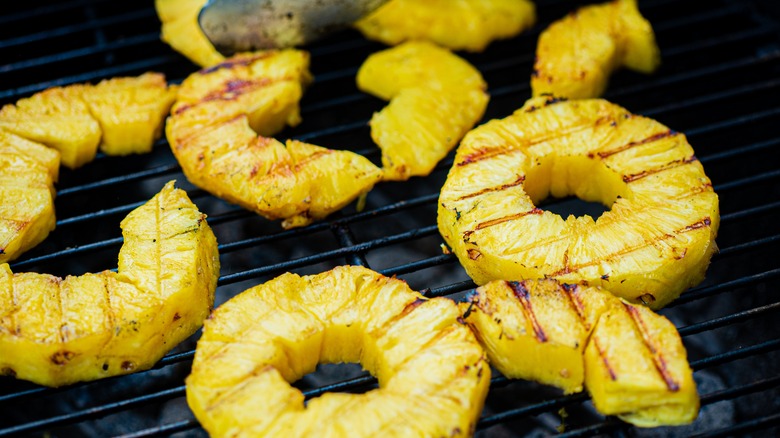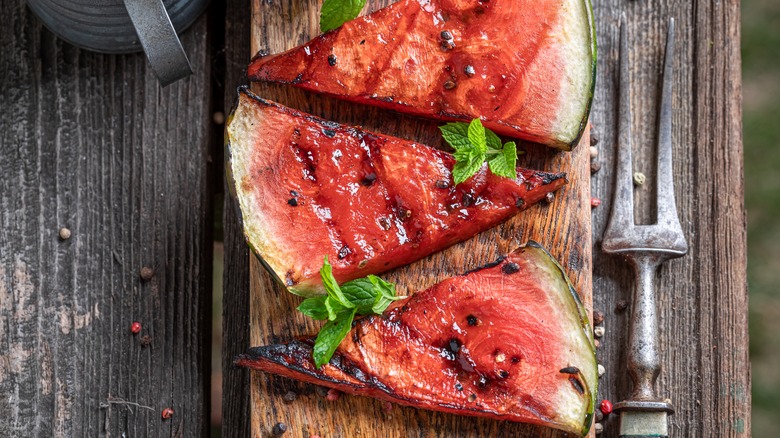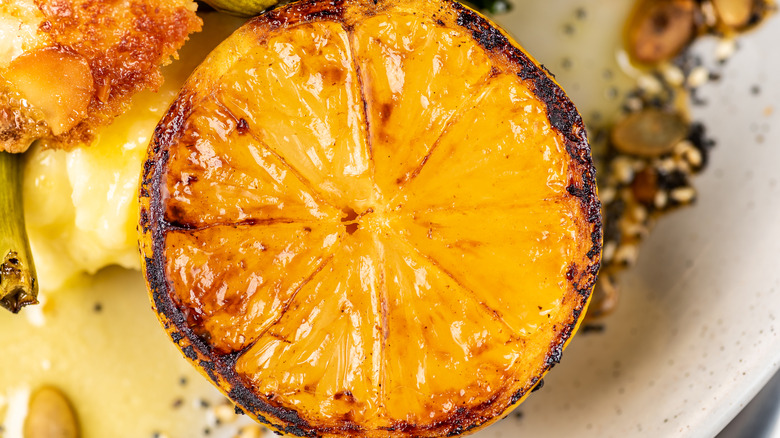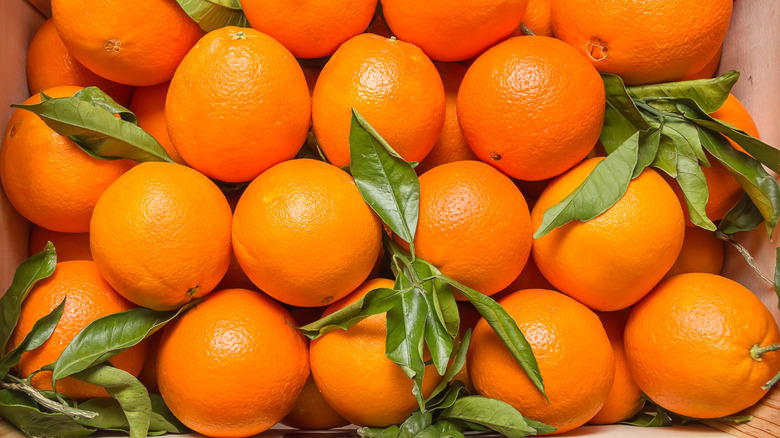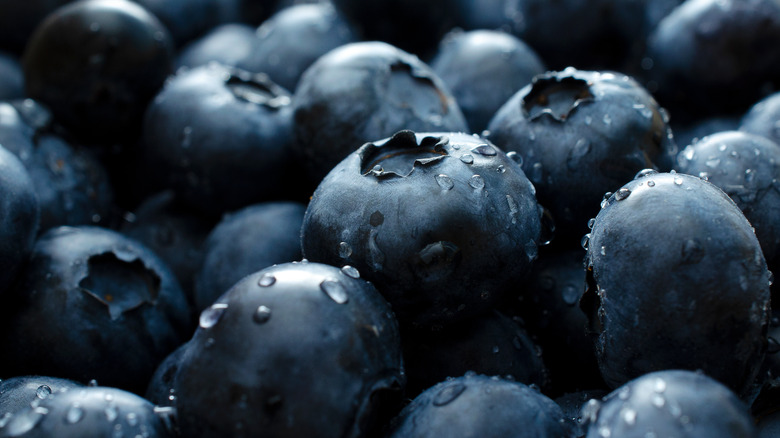11 Best Fruits For Grilling, According To Chef Abra Berens - Exclusive
When warm weather strikes, many of us start preparing our meals outside over a hot grill. While savory items such as meats and vegetables tend to be the first things that comes to mind when thinking of grilled food, many fruits taste great with a touch of smoke and char as well. Some grilled fruits can stand on their own as main courses or desserts, but they can also make a great side dish or topping for meat as well. However, not all fruits do well on the grill.
In order to give you a list of the best fruits for grilling, we asked chef Abra Berens for help. A former farmer, Berens is an expert at making the most of fresh, seasonal, and local ingredients, and her new cookbook, "Pulp," is a celebration of everything you can do with fruit in the kitchen. Organized alphabetically by fruit name, the book is a practical guide that gives you the techniques for getting the most out of fruit, even (perhaps especially) if it might not be at its best.
Berens gave us a host of tips and tricks for grilling fruit. (This list is based on Tasting Table's interview with the chef as well as ideas from "Pulp.") After reading this, you'll be prepared to make room on the grill for something sweet.
1. Peaches/nectarines
We're lumping peaches and nectarines together because nectarines are basically just peaches that don't have fur on their skins. Peaches are the first fruit that Berens ever grilled around 15 years ago, tossing them in a salad with creamy cheese and a balsamic dressing.
Berens likens grilled peaches to burnt marshmallows. The exterior of the fruit caramelizes and even chars black in some spots, adding a bitter undertone that balances the stone fruit's inherent sweetness. In addition to adding these savory notes, grilling also makes the interior of the fruit sweeter; the peach will lose some water, concentrating its flavor. "I tend to use grilling as a way to bump up the flavor in something that's a little underripe or just needs some help," says Berens, who adds that she stays away from grilling peaches that are already perfect.
If you'd like to make grilled peaches the way Berens does, she has a couple of recipes in her book. One combines soft cheese and grilled peaches much in the same way as the salad that made her interested in grilled fruit. However, instead of a salad, Berens puts the grilled peaches on a slice of toasted, garlic-rubbed bread that's been smeared with ricotta. Peppery arugula adds a green touch and mild chili powder contributes some warmth. If you're looking for a grilled nectarine dessert, Bernes suggests pairing the fruit with scones and a sabayon sauce.
2. Apricots
While peaches were Berens' first grilled fruit breakthrough, she finds apricots to be an even better choice when she wants to grill stone fruit. "Apricots have a dryer texture, so I think they tend to be a little easier to grill because they don't stick as much and they take on grill marks and get really lovely," she says. Since apricots aren't as juicy, they can be grilled at a slightly cooler temperature than peaches, which reduces the risk of flare-ups. Still, Berens likes to grill most fruit at a relatively high heat setting because she wants to caramelize the outside without turning the inside of the fruit into a mushy mess.
Grilled apricots are a natural pairing with meat. In "Pulp," Berens pairs a whole chicken that has been quartered and grilled with a kind of relish/salad made from grilled red onion, grilled apricots, olive oil, and basil leaves. She also employs grilled apricots to make a dessert with a slightly savory edge. She takes grilled apricot halves and macerates them in a sweet-and-sour syrup of honey and vinegar, letting them cool to room temperature. When it's time to serve, a sprinkling of toasted pistachios and either honeycomb brittle or crushed meringue pieces adds some crunch to the soft, smoky fruit. If you want to guild the lily, you can garnish it with something creamy like sweetened yogurt or vanilla ice cream.
3. Cherries
You might think cherries would be a poor candidate for grilling since they're so small, but Berens notes that the fruit is able to "pick up smoke flavor really well." If chasing cherries around your grill and losing some of them to the fire doesn't sound like your idea of a good time, Berens has solutions for this problem: "Cook the cherries next to the pork in a frying pan or on tinfoil if you don't have a pan you want to put on the grill." She also recommends putting
Berens pits the cherries and cuts them in half before grilling. In "Pulp," she calls for them to be mixed into a bulgur wheat salad and paired with pork tenderloin, but you could use the grilled fruit in many different ways. Pork loves a fruit sauce, so you could incorporate the cherries into a condiment rather than a salad. Duck would be another great protein to garnish with a grilled cherry sauce. For dessert, we recommend cranking up the heat courtesy of pastry chef Tracy Obolsky's pink pepper pavlova with grilled cherries recipe.
4. Pears
Berens' general criteria for grilling fruits are that they should be on the firmer side and have enough surface area to pick up a decent char and not get lost between the grill grates. Pears fit the bill, especially the mediocre, hard specimens you're likely to find in most supermarkets.
As Berens laments, a perfectly ripe and juicy pear is about as difficult to find in the wild as a unicorn. Cooking them by any method, including grilling, will do a lot to unlock the sweetness and juiciness hidden inside even the most uninspiring, bland pears.
If you do happen to have a particularly juicy pear or are just concerned that the pear will fall apart on the grill, you can always dust the cut side with sugar before grilling. Berens says this works on any kind of fruit (or vegetable — she uses this trick on kohlrabi). The sugar on the surface will caramelize very quickly, giving you the browned flavor you're looking for before the rest of the fruit sogs out.
5. Apples
Apples work well with deeply charred and caramelized flavors. Berens says, "I often roast apples pretty hard." Apples are nice and sturdy, so they should hold up well on the grill. While there aren't any grilled apple recipes in "Pulp," the pan-roasted, peppered apples in the AA++ Salad recipe could easily be swapped out for grilled ones. In the original dish, the apples are seared until brown in a hot skillet with a hefty dose of black pepper. To grill, simply cut apples into hefty slices, toss them in oil, and put them on a hot barbecue. Once brown, season with black pepper.
You could also grill apples to use as an accompaniment to meat. As Berens notes, you can take inspiration from the classic combination of pork and applesauce. The next time you're grilling pork chops, why not toss some apple slices next to the meat? You can simply present the grilled apples next to the pork or take it to the next level and puree them to make applesauce with a smoky, savory edge.
6. Quince
Berens told us that one way she (and many other chefs) come up with creative new recipes is by brainstorming classic flavor combinations and swapping out familiar ingredients for other ones that provide a similar flavor and texture. An example she gave is that quince can be subbed in for apples or pears in many recipes.
Quince tastes like a mix of apple and pear but with a heaping helping of acidity. Berens likes to grill acidic fruit, so quince is a good candidate for the grill. It's also quite hard when raw, which as we know is another good attribute for grilling.
While quince can be cooked on the grill and used as a substitute for recipes that call for pears and apples, it's also great when baked, which softens its flesh and makes it sweeter. Although grilling is often used to apply high heat and sear food, you can also bake on a grill — in fact, Berens employs this method for fruit desserts like cobblers. To bake quince (or anything else), simply heat up half of your grill, leaving the other side cool. Place the food you want to bake on the cool side of the grill and cook with the lid on to create an environment with moderate, even heat.
7. Pineapple
"Pulp," along with most of Berens' other published work, focuses on recipes that take advantage of the agricultural products from the area around her Michigan home. However, she does buy some non-local produce to feed her family, including pineapple, which Berens says is particularly well-suited to the grill. One of her favorite ways to use grilled pineapple is in an al pastor taco. In classic al pastor, the chile-marinaded pork is skewered and cooked in a vertical rotating grill along with pineapple. The juices of the fruit and meat mingle together into a deliciously sweet, spicy, and salty blend.
Although you probably don't have access to a vertical spit at home, you can grill pork and pineapple chunks together on skewers on a normal grill. If you want to get really creative, you can even use grilled pineapple as the base for a cocktail. Our grilled pineapple crush cocktail recipe calls for muddling grilled pineapple wedges with simple syrup and vanilla, then topping with rum, lime juice, and ice to make a refreshing tropical treat. Of course, grilled slices of fresh pineapple taste wonderful on their own as well.
8. Melon
At the risk of stating the obvious, grilling doesn't just change the way fruit tastes — it also heats it up. This can bring another dimension to your recipes. "It adds a nice temperature difference," says Berens. "I really like grilling fruit and serving it with something cold so you get that really nice hot/cold combo."
This technique is on full display in her recipe for grilled melon with grape sherbet. Berens cuts a peeled melon into rings, brushes it with olive oil, and marks it on a hot grill. She serves it with scoops of homemade grape sherbet plopped in the center of the melon ring and garnishes with candied fennel seeds. The melon contains the sherbet as it melts, acting as a sort of edible bowl.
Berens also has a recipe for taking grilled melon in a savory direction. She grills wedges of melon and drizzles them with a salty tahini sauce and some spicy chili oil. The dish plays with the salt-and-sweet flavor combination you might know from dishes like prosciutto and melon, but with a vegan twist that boasts a bit of creaminess from the tahini. A sprinkling of sesame seeds adds some crunch. For another savory spin on grilled melon, try our grilled watermelon salad recipe, which combines the melon with spinach, herbs, cotija cheese, and a balsamic dressing to create a refreshing summer side dish.
9. Lemon
Rather than being the star of the show, grilled lemon is more useful as a way to elevate other foods. The simplest way to incorporate grilled lemon into a dish is to simply cut it in half and sear the cut sides on the grill until they're caramelized and slightly charred. Not only does this look attractive and dramatic, but it also changes the flavor of the lemon. Per Berens, "It cuts some of the extreme acidity from the lemon and makes it a little bit sweeter." You can try this trick with any food that tastes good with a bit of lemon squeezed on it: seafood, grilled meats, and vegetables would all work well. If you're not a fan of mouth-puckering sourness, charred lemon might be up your alley.
If you're willing to put a little more work into your grilled lemon, Berens recommends a grilled lemon relish. Start by cutting the lemon into quarters and remove the seeds. Grill the wedges skin side down until the skin is a little charred and blistered, then grill the flesh side. Let this cool, then chop finely either by hand or with a food processor. Mix with olive oil, herbs, and chili flakes to make a condiment that goes perfectly with any sort of grilled meat. This recipe is great because it allows you to use the whole fruit rather than just the juice or the zest, cutting down on waste.
10. Oranges
The height of citrus season in many parts of the world happens in winter, which doesn't make for great grilling weather. However, that doesn't prevent Berens from adding grilled flavor to citrus; she just uses indoor cooking methods to create a similar effect. "I've done a burnt orange relish the same way as the lemon, but under a broiler to really blacken the skin," she says. If you don't have access to a broiler. a heavy, ripping-hot skillet can give you a similar effect as well.
If you would like to do your oranges outdoors, you can also sear them on a cast-iron griddle or pan heated over your grill. To add extra layers of bittersweet caramelized flavor, cover the cut side of halved oranges with sugar and blacken them on the hot griddle cut-side down. The burnt sugar brings complexity to a simple orange with hints of smokiness and just the right amount of char.
11. Blueberries
While Berens didn't specifically mention grilling blueberries in our interview, she did talk about how much she enjoys pairing them with savory ingredients. "One thing fruit adds to a savory dish is acidity," says Berens. "I tend to work with a tarter blueberry or a tarter apricot for that reason." She uses the example of pork and apples to illustrate why blueberries taste good with meat. According to Berens, "a blueberry and venison or blueberry and lamb recipe to me is very similar to pork and apples, they're both just darker. Lamb meat is a darker red and has a gamier flavor than pork. Blueberries are more tannic than apples are."
If you're grilling lamb or venison, try serving the meat with a blueberry compote to bring some bright acidity to the savory meat. You could take this one step further by using Berens' technique for grilling cherries and applying it to blueberries, cooking them in a skillet on the grill next to the meat. This would infuse the berries with extra smokiness to lend the dish an intense open-fire flavor.
